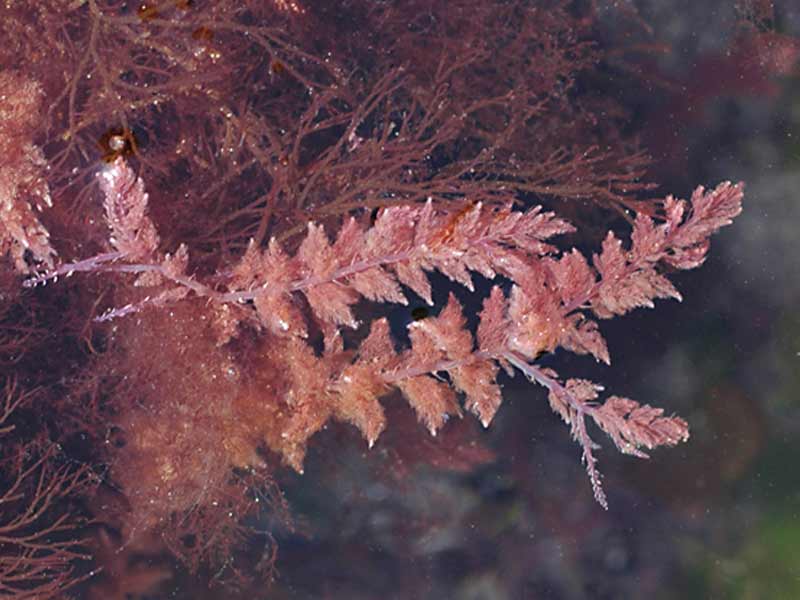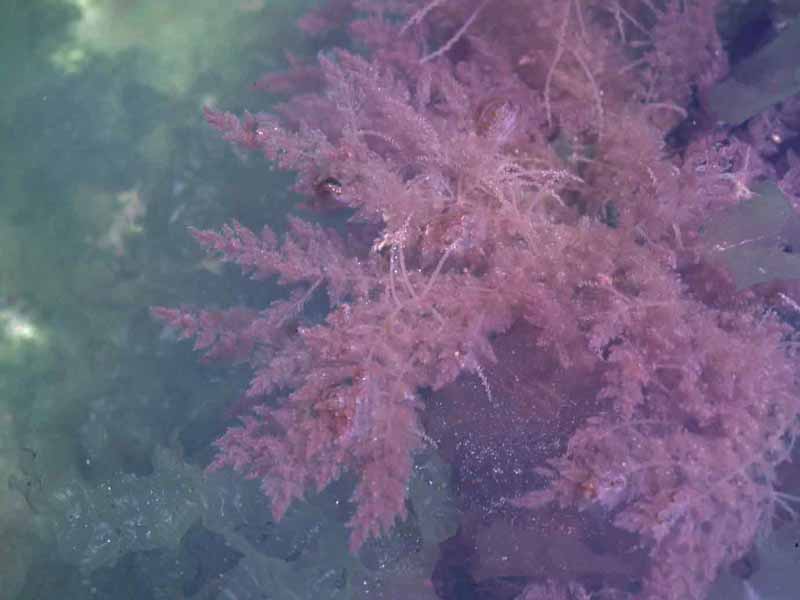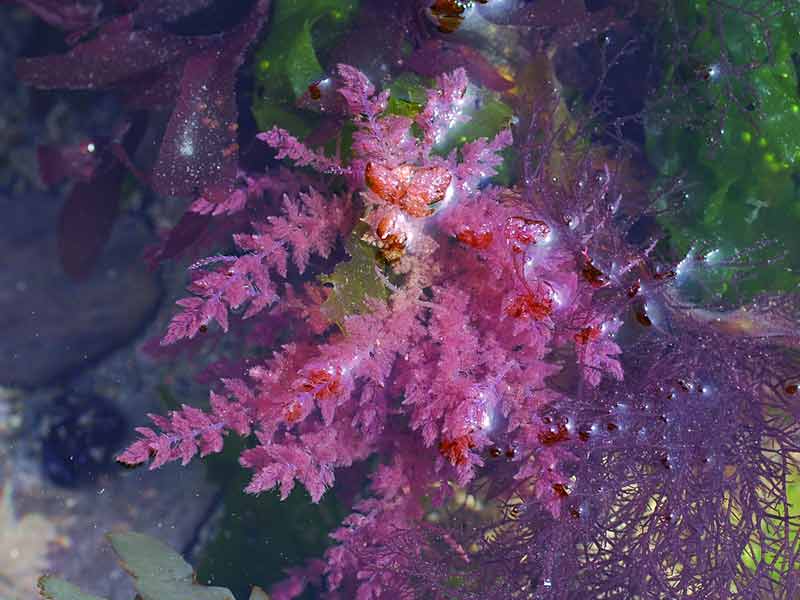Harpoon weed (Asparagopsis armata)
Distribution data supplied by the Ocean Biodiversity Information System (OBIS). To interrogate UK data visit the NBN Atlas.Map Help
| Researched by | Marie Skewes | Refereed by | Admin |
| Authority | Harvey, 1855 | ||
| Other common names | - | Synonyms | - |
Summary
Description
Recorded distribution in Britain and Ireland
Tetrasporophyte plants occur as far north as Shetland but not eastern Scotland. Gametophyte plants (red on the map) are described as present in south-west England and in western Ireland but occur sporadically and may be absent for many years.
Global distribution
Outside of the British Isles this red alga extends to the Atlantic coast of France, Spain and Portugal into the Mediterranean. It originated in the Pacific and Indian oceans.
Habitat
The sexual (gametophyte) plant is found in the shallow sublittoral or in deep littoral pools attached to other algae by its barbed axes. The asexual (tetrasporophyte) plant is typically found sublittorally and is epiphytic or sometimes free-living.
Depth range
-Identifying features
- Apical tufts of sexual (gametophyte) plant pyramidal in outline, composed of spirally-arranged branches arising in pairs.
- The plants have barbed rhizoids which are smooth except for the barbs.
- Cystocarps are shortly stalked, relatively large and clustered on main axis.
Additional information
The asexual (tetrasporangial) phase of Asparagopsis armata was once described as a separate species, Falkenbergia rufolanosa. The alga is a non-native species first recorded in Ireland in Galway Bay in 1939 and Britain in 1949 at Lundy in the Bristol Channel.Listed by
- none -
Bibliography
Dickinson, C.I., 1963. British seaweeds. London & Frome: Butler & Tanner Ltd.
Dixon, P.S. & Irvine, L.M., 1977. Seaweeds of the British Isles. Volume 1 Rhodophyta. Part 1 Introduction, Nemaliales, Gigartinales. London: British Museum (Natural History) London.
Eno, N.C., Clark, R.A. & Sanderson, W.G. (ed.) 1997. Non-native marine species in British waters: a review and directory. Peterborough: Joint Nature Conservation Committee.
Guiry, M.D. & Dawes, C.J., 1992. Daylength, temperature and nutrient control of tetrasporogenesis in Asparagopsis armata (Rhodophyta). Journal of Experimental Marine Biology and Ecology, 158, 197-217.
Hardy, F.G. & Guiry, M.D., 2003. A check-list and atlas of the seaweeds of Britain and Ireland. London: British Phycological Society
Hiscock, S., 1986b. A field key to the British Red Seaweeds. Taunton: Field Studies Council. [Occasional Publication No.13]
Howson, C.M. & Picton, B.E., 1997. The species directory of the marine fauna and flora of the British Isles and surrounding seas. Belfast: Ulster Museum. [Ulster Museum publication, no. 276.]
Datasets
Fenwick, 2018. Aphotomarine. Occurrence dataset http://www.aphotomarine.com/index.html Accessed via NBNAtlas.org on 2018-10-01
Manx Biological Recording Partnership, 2017. Isle of Man wildlife records from 01/01/2000 to 13/02/2017. Occurrence dataset: https://doi.org/10.15468/mopwow accessed via GBIF.org on 2018-10-01.
National Trust, 2017. National Trust Species Records. Occurrence dataset: https://doi.org/10.15468/opc6g1 accessed via GBIF.org on 2018-10-01.
Nature Locator, 2017. Sealife Tracker. Occurrence dataset: https://doi.org/10.15468/qgk3pg accessed via GBIF.org on 2018-10-01.
NBN (National Biodiversity Network) Atlas. Available from: https://www.nbnatlas.org.
OBIS (Ocean Biodiversity Information System), 2025. Global map of species distribution using gridded data. Available from: Ocean Biogeographic Information System. www.iobis.org. Accessed: 2025-08-08
Outer Hebrides Biological Recording, 2018. Invasive Non-Native Species, Outer Hebrides. Occurrence dataset: https://doi.org/10.15468/30erdy accessed via GBIF.org on 2018-10-01.
Citation
This review can be cited as:
Last Updated: 27/06/2003





